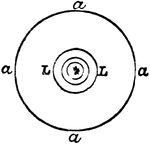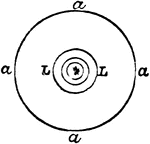Clipart tagged: ‘Lenses’

Catadioptric Holophote
"Catadioptric Holophote.—Part of the anterior hemisphere of rays is intercepted and at once parallelized…

Catadioptric Holophote
"Catadioptric Holophote.—Part of the anterior hemisphere of rays is intercepted and at once parallelized…
Optical Position and Size of Image Through Lens in Front of Eye
The illustration of putting lenses in front of the eye. The focal point of the image is reflected into…

Holophotal Catadioptric
"Holophotal Catadioptric Apparatus Revolving round a Central Flame." —The Encyclopedia Britannica,…

Convex Lens
"When the object is at a long distance from the lens, the image formed is smaller than the object, and…

Compound Microscope
"This consists of two convex lenses, by one of which the image is formed within the tube of the instrument,…

Optical Position and Size of Image Through Magnifying Glasses
"If y be the object the image appears to a normal eye situated behind the system L with passive accommodation…

Optical Position of Diaphragms using Lens
"The intersection of the principal rays in this case lies in the middle of the entrance pupil or of…

Polarization of Light
"The effect of holding polarizing lenses at right angles to each other." -Avery 1895

A Collection of Spectacles
"A, spectacles with bows hinged to the shoulders on the rims connected by the nose or bridge. B, spectacles…

Stevensons Revolving Light
"In 1835 Mr. Stevenson, in a report to the Northern Lighthouse Board, proposed to add fixed reflecting…
Double Refracting Telescope
"The inversion of the object is of little consequence when the instrument is employed for astronomical…
Refracting Telescope
"Suppose the object o to be at such a distance, that the rays of light from it pass in parallel lines,…